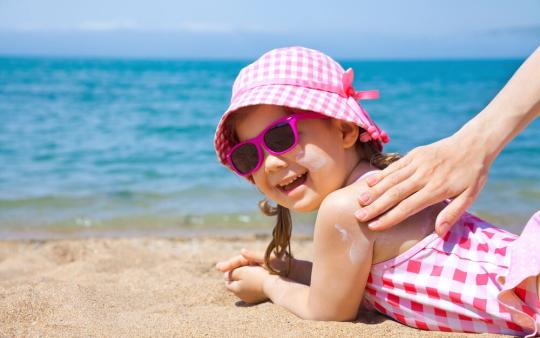When the days get longer, hotter, and brighter, we bask in the mood-altering warmth and sunshine and can barely resist the lure of their charms. But our renewed love of the outdoors also increases our risk of getting a sunburn tremendously. Here are some things to know about protecting your family's skin from our fair-weather friend, the sun.
Sunburn 101
There are three classifications of sunburns:
First degree sunburn is the least severe and the most common, with symptoms including hot, red, and sometimes painful skin. It is present only on the epidermis.
Second degree sunburn reaches the lower layer of skin (the dermis) and may also include swelling and blistering.
Third degree sunburn penetrates into deeper tissue and results in white or blackened skin that may be numb.
Sunburns are caused by radiation from the sun, which comes in two forms:
UVA is present year-round. UVA rays have the ability to penetrate deeper and can even pass through clothing and windows. These rays are responsible for free radical damage to the skin, increasing our risk of melanoma.
UVB is more commonly present during the summer months. UVB rays can penetrate the first layer of skin and are associated with what we typically know as sun damage: the dreaded sunburn.
Preventing sunburns
Here are some preventative tips to keep you from looking like a lobster!
-
Limit outdoor time during peak hours(10 am to 3 pm) when the rays are strongest .
-
Wear protective clothing and accessories such as a hat, sunglasses, and loose, lightweight, light-coloured clothing.
-
Apply a natural, physical sunscreen when you or your child are going out in the sun, making sure to cover all areas of exposed skin. Cover with a thick and even layer, and re-apply every few hours, especially after your child has been swimming.
Choosing a sunscreen
Sunscreens come in a variety of forms, and can be composed of many ingredients, making it quite difficult to choose the best sunscreen for your child. When choosing a sunscreen, here are some things to keep in mind:
SPF values
SPF stands for sun protection factor and provides a measure of how long a sunscreen will protect your skin from UVB (the burning kind) rays. Oftentimes, a high SPF offers a false sense of security as many people believe they can remain in the sun much longer than they are actually protected for.
The Environmental Working Group (EWG) offers the example of 100 SPF sunscreen. While many may think they can now be out in the sun 100 times longer than without any, the actual difference in protection between SPF 50 and SPF 100 is 1%. True story. When applied appropriately, an SPF of 50 will be effectively just as protective as the higher ratings. Furthermore, the higher the SPF, the more chemicals, and therefore associated health risks, required in that batch of sunscreen. Finally, sunscreen is not as effective at protecting from the more penetrative and powerful UVA radiation, so higher SPF, with its false sense of greater protection, may result in people spending too much time in the sun and exposing themselves to greater damage overall.
EWG goes so far as to state that they believce that SPF sunscreen higher than 50 should not be sold to consumers, so that instructions on appropriate use and protection are clear.
Mineral-only sunscreens
Sunscreens are available in two forms - mineral (barrier or physical) or non-mineral (usually chemical). Generally, mineral sunscreens composed of zinc-oxide or titanium dioxide are stable in the sunlight and provide a balance of both UVA and UVB protection. If mineral sunscreens are difficult to source, non-mineral sunscreens containing Tinosorb S, Tinosorb M, Mexoryl SX and Mexoryl XL also provide sun-stability and appear to protect the skin from both UVA and UVB rays.
Lotions over sprays
When using a lotion, there is the opportunity to provide a thick and even coating of sunscreen on the skin. Sunscreen sprays do not provide a thick and even coating, and also pose an inhalation risk and contaminate the air.
Caring for burns
Sometimes no matter how much protection we use, burns occur. Here are a few ways to help treat a first-degree sunburn:
Get out of the sun!
If you begin to notice that your child is developing a sunburn, take them out of the sun!
Cool bath or cold compress
Aids in relieving the heat and pain.
Aloe vera gel
Aloe is used to help heal wounds (including burns), and provides a cool, soothing relief to the skin.
Nettle lotion
Helps with the symptoms of stinging and burning.
Eat your antioxidants
Berries and green veggies contain antioxidants, which help protect the body’s cells from the results of sun damage from the inside
Vitamin C and zinc
Helps with healing the skin after sun exposure
Water
Dehydration and sunburns commonly go hand in hand. Be sure that your child remains hydrated, especially after spending any time outside in the heat.
If your child’s skin becomes severely blistered or swollen due to a sunburn, and experiences symptoms such as fever, chills, or nausea, seek medical attention right away.
For a much greater overview of all things sunscreen from the Environmental Working Group, check out their Sunscreen Guide.
Have a safe and happy summer!



